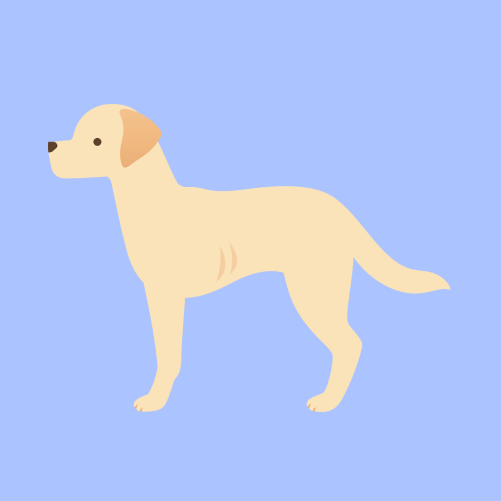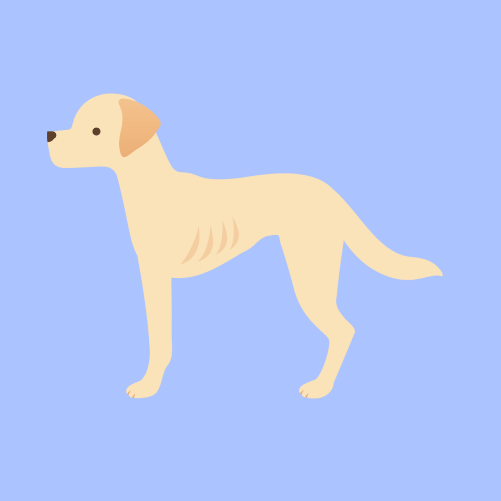Is your dog a healthy weight?

Is your dog a healthy weight?
Helping our pets reach and maintain a healthy weight is one of the best things we can do for them, but what a “healthy weight” looks like isn’t widely understood by pet owners. The Association for Pet Obesity Prevention’s 2022 U.S. Pet Obesity Prevalence Survey showed that an alarming 61% of cats and 59% of dogs in America were overweight or suffering from obesity. These staggering numbers represent a clear indication of a serious health problem in American pets. And a follow-up survey revealed a maybe more concerning reality – that a mere 28% of cat owners and 17% of dog owners acknowledged that their pets were overweight, with 84% of dog and 70% of cat owners stating that their pets were a perfectly healthy weight. Obviously, something’s not adding up here, and our pets are the ones suffering.
How to tell if your dog is a healthy weight.
There is no one-size-fits-all when it comes to a healthy weight for our animals. The ranges can vary widely among the various dog breeds, and even differ when it comes to male dogs vs. females. It’s important to keep an eye on your pet’s weight, especially as they age, so you can ensure that they are staying healthy. But this isn’t always so easy to do, so we’re sharing some tips on how you can determine if your dog is a healthy weight or if they need some help.
What an overweight or obese dog looks like.

They don’t have a defined waist.
Dogs that are overweight will often have no visible waistline from above and there will be little to no distinction between their chest, ribcage, or stomach when you look at them from the sides. Their body is the same thickness from head to tail, or their stomach (or “tuck”) is not well defined or is overly rounded.
You can’t see or feel their ribs and there’s extra fat where there shouldn’t be.
Their ribs and hip points are covered in a layer of fat, preventing you from seeing them and you will feel the fat when you reach for them. Overweight dogs may also have additional fat deposits on their chest, neck, and the base of their tail.
They’re probably slow-moving and struggle during exercise.
Overweight dogs will often show less interest in exercising, move slowly and need to take frequent breaks on walks, and often pant during even a low-level of exertion. They’re carrying around more body weight so it’s harder for them to maneuver.
What a dog at a healthy weight looks like.

They have a defined waist.
Dogs that are a healthy weight will have a defined waist that you’re able to see when looking at them from above. Every dog, regardless of their breed, should have a waist that’s visible from above – even the more muscular breeds like Bulldogs, American Staffordshire Terriers, and Cani Corsi.
Some of their ribs are visible.
If your dog is a healthy weight and they don’t have a thick coat of fur, you should see a light outline of the last 1-3 ribs when the dog is standing normally, depending on their coat length and body shape. And their hip points should typically be visible just under the skin. However, it is normal to see more ribs when a dog is turning, leaning down to eat, or breathing in from exercising or sniffing. Likewise, the spine may be slightly visible when a dog is laying down in a curled position.
You can see a clear distinction between their chest and their abdomen.
Your dog’s abdomen should tuck up from just behind their ribcage to their hips and this distinction will be visible from the side.
What an underweight dog looks like.

Their waist looks too skinny.
Dogs that are underweight will have a waist that will look overly thin from above and you won’t see much muscle mass, if any at all.
Prominent ribs, hips, and spine.
One of the most telltale signs of an underweight dog is when they have multiple ribs, their hip points, and their spine protruding from under their fur. You’ll be able to see these sticking out when you look at them from the top down as well as from the sides. That said, it’s important to note that this does not apply to sighthounds (Greyhounds, Irish Wolfhounds, etc.) as they are naturally very slender and you will be able to see and feel more of their ribs and hips than what would normally be considered ideal.
Their fur may look patchy and dull.
Oftentimes, hair loss and other skin conditions are caused by malnutrition so if your dog is underweight, you may also notice changes for the worse in their coat and skin.
Sometimes you need to get handsy.
For dogs that have thicker fur (Huskies, German Shepherds, etc.), it may not be as easy to tell whether they are a healthy weight or not just by looking at them. In these cases, you can use your hands to feel along your dog’s body for clues. The below guidelines are based on an average human hand:
What “overweight” feels like.
Flatten your hand and with your palm up, use your other hand to feel the fleshy pad below your thumb and above your wrist – if your dog’s ribcage feels similar, that’s a good sign that they’re overweight. Run your hand along your dog’s ribcage and if you can’t feel any ribs or have to push in to feel them, your dog is overweight or maybe obese.
What a healthy weight feels like.
Flatten your hand and with your palm facing down, use your other hand to run a ringer across your flat knuckles. Similar to how this feels, a healthy dog’s ribs should be easily felt but not protruding. Run your hand along your dog’s ribcage to feel for this.
What “underweight” feels like.
Clench one of your hands into a fist and use the other to feel across the ridges of your clenched knuckles. Then run your hand along your dog’s ribcage and if their ribs protrude in a similar way to your clenched knuckles, the dog is underweight.
The risk of not maintaining a healthy weight in your dogs.
There are plenty of studies that show that dogs at a healthy weight will live longer. And it just makes sense! Like in humans, obesity in dogs can contribute to many health problems (like joint and mobility issues, heart problems, diabetes, etc.) that impact their quality of life and longevity. If an overweight dog is struggling to lose weight with proper diet, calorie control, and exercise, ask your vet to run a full thyroid panel (not just T4) to help rule out any potential underlying health conditions that may be preventing them from losing weight. Additionally, be aware of the iodine dosage in kelp supplements. Many pet kelp products do not take iodine into account and the feeding recommendations drastically overdose this nutrient. This has the possibility of affecting thyroid health and, therefore, a dog’s weight.
Feed a raw diet to help your dog maintain a healthy weight.
There are a myriad of benefits to feeding your dog a raw diet, but one of our favorites is that it can make it so much easier to manage and maintain a healthy weight. Kibble and canned pet food often contain a ton of starchy carbohydrates and unnecessary filler ingredients that don’t provide much nutritional value to our dogs – mostly empty calories. And a lot of the time we don’t even really know what the exact ingredients in these types of foods are. With a raw diet, you have control over every ingredient you’re feeding your pet which allows you to more easily manage their weight.